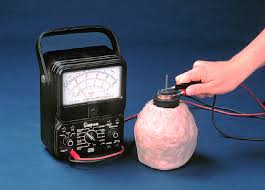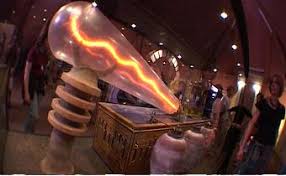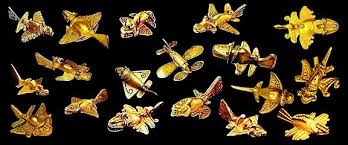Ancient Technologies wondering the world:
seem like evidence of lost civilizations or alien visitors. Which ones
are misinterpretations or hoaxes, and which are the real thing?
Reliable evidence of startlingly advanced ancient technology is few and far.
The Baghdad Battery:
 So far, most of these ancient techs have been frauds or
pseudoscientific misinterpretations. Did ancient people ever actually
create cool advanced technology? How about functional electric batteries
capable of producing nearly a volt of power each? Yes, the famous
Baghdad Batteries (top image) found in the 1930s in Iraq really work.
Each battery (about a dozen were found) consists of a 5-inch clay jar.
Inside is a copper tube wrapped around an iron rod. Acidic residue was
found at the bottom of the pot, and an asphalt stopper sealed the top.
So far, most of these ancient techs have been frauds or
pseudoscientific misinterpretations. Did ancient people ever actually
create cool advanced technology? How about functional electric batteries
capable of producing nearly a volt of power each? Yes, the famous
Baghdad Batteries (top image) found in the 1930s in Iraq really work.
Each battery (about a dozen were found) consists of a 5-inch clay jar.
Inside is a copper tube wrapped around an iron rod. Acidic residue was
found at the bottom of the pot, and an asphalt stopper sealed the top.
 They worked
in much the same way as modern batteries,
They worked
in much the same way as modern batteries,
just not as efficiently. An acidic liquid placed at the bottom would transfer electrons from one metal to another, creating voltage at the "terminal" poking through the asphalt plug. Numerous replications have been built and tested, using lemon juice, vinegar or grape juice as the electrolytic fluid. The Mythbusters even took a shot at it (result: Plausible).
 No one is
totally sure what ancient people used batteries for. There are a few
theories. My favorite revolves around the discovery of ornaments that
appear to have undergone electroplating, which uses a small current to
evenly apply molecules of a substance (such as gold) to an object. It's
possible there was some kind of medical/therapeutic use as well. The Mythbusters demonstrated the "experience the power of the divine"
theory, rigging a religious idol so that true believers and
non-believers alike would get a potent but non-fatal jolt. Were ancient
priests resorting to parlor tricks to drum up faith? I guess they didn't
have mud-encased spark plugs to fall back on.
No one is
totally sure what ancient people used batteries for. There are a few
theories. My favorite revolves around the discovery of ornaments that
appear to have undergone electroplating, which uses a small current to
evenly apply molecules of a substance (such as gold) to an object. It's
possible there was some kind of medical/therapeutic use as well. The Mythbusters demonstrated the "experience the power of the divine"
theory, rigging a religious idol so that true believers and
non-believers alike would get a potent but non-fatal jolt. Were ancient
priests resorting to parlor tricks to drum up faith? I guess they didn't
have mud-encased spark plugs to fall back on.
Pyramid Capstone:
 When you look up at the Great Pyramid, it’s apex is missing. It is
flap topped and not pointed like a pyramid should be. Usually, when a
pyramid was constructed, the top part, or capstone (also called
top-stone), was the last thing to be placed on it. It was considered the
most important part of the pyramid and was made of special stone or
even gold. The capstone was usually highly decorated.
When you look up at the Great Pyramid, it’s apex is missing. It is
flap topped and not pointed like a pyramid should be. Usually, when a
pyramid was constructed, the top part, or capstone (also called
top-stone), was the last thing to be placed on it. It was considered the
most important part of the pyramid and was made of special stone or
even gold. The capstone was usually highly decorated.
 Was the great pyramid always without a capstone or was it stolen,
destroyed, etc? No one knows but the accounts of visitors to the pyramid
from the ancient past (as far back as the time of Christ) always
reported that the pyramid lacked a capstone. It is possible that it was
never finished. Another possibility is that capstones were sometimes
made of gold and maybe the first thing looted. The only problem is that
this would be a very large capstone. If you climbed to the top, you
could walk around very freely on the pyramid as many have done. It is
about 30 feet in each direction. Thus, this capstone would have been
huge and weighed a tremendous amount. Also on the summit you would see
something that looks like a mast or flagpole. Actually it was placed
there by two astronomers in 1874 to show where the Pyramid’s actual apex
would have been if finished.
Was the great pyramid always without a capstone or was it stolen,
destroyed, etc? No one knows but the accounts of visitors to the pyramid
from the ancient past (as far back as the time of Christ) always
reported that the pyramid lacked a capstone. It is possible that it was
never finished. Another possibility is that capstones were sometimes
made of gold and maybe the first thing looted. The only problem is that
this would be a very large capstone. If you climbed to the top, you
could walk around very freely on the pyramid as many have done. It is
about 30 feet in each direction. Thus, this capstone would have been
huge and weighed a tremendous amount. Also on the summit you would see
something that looks like a mast or flagpole. Actually it was placed
there by two astronomers in 1874 to show where the Pyramid’s actual apex
would have been if finished.
 On the back of a dollar bill, you can see a pyramid with a flat top.
No one has been able to explain why the Great Pyramid would have been
built without a capstone.
On the back of a dollar bill, you can see a pyramid with a flat top.
No one has been able to explain why the Great Pyramid would have been
built without a capstone.
This is an interesting story associated with a visit to the top of the great pyramid. Many tourists have climbed to the top, which is not an easy journey. One such person was Sir Siemen’s, a British inventor. He climbed to the top with his Arab guides. One of his guides called attention to the fact that when he raised his hand with outspread fingers, he would hear an acute ringing noise. Siemen raised his index finger and felt a distinct prickling sensation. He also received an electric shock when he tried to drink from a bottle of wine that he had brought with him. Being a scientist, Siemen than moistened a newspaper and wrapped it around the wine bottle to convert it into a Leyden jar (an early form of a capacitor). When he held it above his head, it became charged with electricity. Sparks then were emitted from the bottle. One of the Arab guides got frightened and thought Siemen was up to some witchcraft and attempted to seize Siemen’s companion. When Siemen’s noticed this, he pointed the bottle towards the Arab and gave him such a shock that it knocked the Arab to the ground almost rendering him unconscious. When he recovered, he took off down the pyramid shouting loudly. What kind of natural phenomena on the top of the Great Pyramid could produce such an electo-static effect? It would be interesting to conduct additional physics experiments on the top of the Great Pyramid.
Klerksdorp Spheres:
When miners near the South African town of Klerksdorp started finding small metallic spheres that seemed to have symmetrical grooves machined into them, they thought it was weird. When the spheres were noticed to have been encased in pyrophillite that was a couple of billion years old, some people immediately jumped on board the Time Travelers/Ancient Aliens/Creationist bandwagon. Many of the reported facts do seem amazing: that they are perfectly spherical; that they are made of an unknown metal that doesn't exist on Earth; that they spin around when left alone.
 Of course,
none of these things are actually true. Klerksdorp Spheres are the
result of concretions, geologic formations that fill air bubbles in the
overlying strata. They aren't perfectly spherical at all. Some of them
take the form of multiple spheres stuck together, and others are more
like discs. As for the mysterious material? Most of them are made of
various forms of iron. The spinning thing is just pure bunk. Of course,
the spheres are unique among the objects on this list in that they come
from a natural phenomenon rather than being human-made at all. That
hasn't stopped humans from using them to propel their agendas, though.
Of course,
none of these things are actually true. Klerksdorp Spheres are the
result of concretions, geologic formations that fill air bubbles in the
overlying strata. They aren't perfectly spherical at all. Some of them
take the form of multiple spheres stuck together, and others are more
like discs. As for the mysterious material? Most of them are made of
various forms of iron. The spinning thing is just pure bunk. Of course,
the spheres are unique among the objects on this list in that they come
from a natural phenomenon rather than being human-made at all. That
hasn't stopped humans from using them to propel their agendas, though.
The Ancient Airplanes of Egypt and South America:
 Two separate claims seem to suggest the same astonishing conclusion:
ancient peoples of Egypt and South America both had flight technology
thousands of years before modern humans developed it. In South America,
the idea is based on jewelry produced by the Chimú culture that existed
in what is now Colombia about 2,000 years ago. Some of the small
pendants and ornaments appear to depict human-made aircraft, including
delta wing shapes, tail fins and even a cockpit. Amazing! However,
considering that all the jewelry produced by the Chimú takes the form of
stylized birds and insects, Occam's Razor suggests that the ornament
maker happened to carve a bird shape that looks sort of like an airplane
to a modern human.
Two separate claims seem to suggest the same astonishing conclusion:
ancient peoples of Egypt and South America both had flight technology
thousands of years before modern humans developed it. In South America,
the idea is based on jewelry produced by the Chimú culture that existed
in what is now Colombia about 2,000 years ago. Some of the small
pendants and ornaments appear to depict human-made aircraft, including
delta wing shapes, tail fins and even a cockpit. Amazing! However,
considering that all the jewelry produced by the Chimú takes the form of
stylized birds and insects, Occam's Razor suggests that the ornament
maker happened to carve a bird shape that looks sort of like an airplane
to a modern human.
 The
Egyptian airplane is a similar case. A wooden falcon found in Saqqara
was later reported by Egyptian doctor Khalil Messiha to have exceptional
flight properties. Messiha's claims were inflated and distorted over
the years until the wooden toy was held as an example of perfect
aerodynamic form, inexplicable for such an ancient culture. Digging a
little deeper, however, reveals that the bird carving closely resembles
wind vanes mounted on the masts of Egyptian riverboats, and that the
design in fact violates many aerodynamic principles. Messiha's original
claim that it could "sail in the air for a few yards when thrown by
hand" is likely true. So will a brick.
The
Egyptian airplane is a similar case. A wooden falcon found in Saqqara
was later reported by Egyptian doctor Khalil Messiha to have exceptional
flight properties. Messiha's claims were inflated and distorted over
the years until the wooden toy was held as an example of perfect
aerodynamic form, inexplicable for such an ancient culture. Digging a
little deeper, however, reveals that the bird carving closely resembles
wind vanes mounted on the masts of Egyptian riverboats, and that the
design in fact violates many aerodynamic principles. Messiha's original
claim that it could "sail in the air for a few yards when thrown by
hand" is likely true. So will a brick.
The Baghdad Battery:
just not as efficiently. An acidic liquid placed at the bottom would transfer electrons from one metal to another, creating voltage at the "terminal" poking through the asphalt plug. Numerous replications have been built and tested, using lemon juice, vinegar or grape juice as the electrolytic fluid. The Mythbusters even took a shot at it (result: Plausible).
Pyramid Capstone:
This is an interesting story associated with a visit to the top of the great pyramid. Many tourists have climbed to the top, which is not an easy journey. One such person was Sir Siemen’s, a British inventor. He climbed to the top with his Arab guides. One of his guides called attention to the fact that when he raised his hand with outspread fingers, he would hear an acute ringing noise. Siemen raised his index finger and felt a distinct prickling sensation. He also received an electric shock when he tried to drink from a bottle of wine that he had brought with him. Being a scientist, Siemen than moistened a newspaper and wrapped it around the wine bottle to convert it into a Leyden jar (an early form of a capacitor). When he held it above his head, it became charged with electricity. Sparks then were emitted from the bottle. One of the Arab guides got frightened and thought Siemen was up to some witchcraft and attempted to seize Siemen’s companion. When Siemen’s noticed this, he pointed the bottle towards the Arab and gave him such a shock that it knocked the Arab to the ground almost rendering him unconscious. When he recovered, he took off down the pyramid shouting loudly. What kind of natural phenomena on the top of the Great Pyramid could produce such an electo-static effect? It would be interesting to conduct additional physics experiments on the top of the Great Pyramid.
Klerksdorp Spheres:
When miners near the South African town of Klerksdorp started finding small metallic spheres that seemed to have symmetrical grooves machined into them, they thought it was weird. When the spheres were noticed to have been encased in pyrophillite that was a couple of billion years old, some people immediately jumped on board the Time Travelers/Ancient Aliens/Creationist bandwagon. Many of the reported facts do seem amazing: that they are perfectly spherical; that they are made of an unknown metal that doesn't exist on Earth; that they spin around when left alone.
The Ancient Airplanes of Egypt and South America:


No comments:
Post a Comment